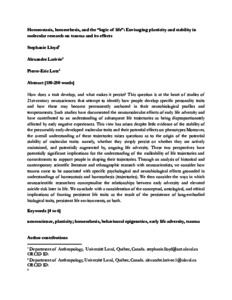Lloyd, Stephanie and Larivée, Alexandre and Lutz, Pierre-Eric
(2022)
Homeostasis, homeorhesis, and the “logic of life”: Envisaging plasticity and stability in molecular research on trauma and its effects.
[Preprint]
![[img]](https://philsci-archive.pitt.edu/20513/1.hassmallThumbnailVersion/Homeostasis%2C%20homeorhesis%2C%20and%20the%20%E2%80%9Clogic%20of%20life%E2%80%9D%20Envisaging%20plasticity%20and%20stability%20in%20molecular%20research%20on%20trauma%20and%20its%20effects_15%20dec%202021.pdf)  Preview |
|
Text
Homeostasis, homeorhesis, and the “logic of life” Envisaging plasticity and stability in molecular research on trauma and its effects_15 dec 2021.pdf
Download (258kB)
| Preview
|
Abstract
How does a trait develop, and what makes it persist? This question is at the heart of studies of 21st-century neurosciences that attempt to identify how people develop specific personality traits and how these may become permanently anchored in their neurobiological profiles and temperaments. Such studies have documented the neuromolecular effects of early life adversity and have contributed to an understanding of subsequent life trajectories as being disproportionately affected by early negative experiences. This view has arisen despite little evidence of the stability of the presumably early-developed molecular traits and their potential effects on phenotypes Moreover, the overall understanding of these trajectories raises questions as to the origin of the potential stability of molecular traits: namely, whether they simply persist or whether they are actively maintained, and potentially augmented by, ongoing life adversity. These two perspectives have potentially significant implications for the understanding of the malleability of life trajectories and commitments to support people in shaping their trajectories. Through an analysis of historical and contemporary scientific literature and ethnographic research with neuroscientists, we consider how trauma came to be associated with specific psychological and neurobiological effects grounded in understandings of homeostasis and homeorhesis (trajectories). We then consider the ways in which neuroscientific researchers conceptualize the relationships between early adversity and elevated suicide risk later in life. We conclude with a consideration of the conceptual, ontological, and ethical implications of framing persistent life traits as the result of the persistence of long-embodied biological traits, persistent life environments, or both.
Available Versions of this Item
-
Homeostasis, homeorhesis, and the “logic of life”: Envisaging plasticity and stability in molecular research on trauma and its effects. (deposited 29 Apr 2022 03:44)
[Currently Displayed]
Monthly Views for the past 3 years
Monthly Downloads for the past 3 years
Plum Analytics
Actions (login required)
 |
View Item |




